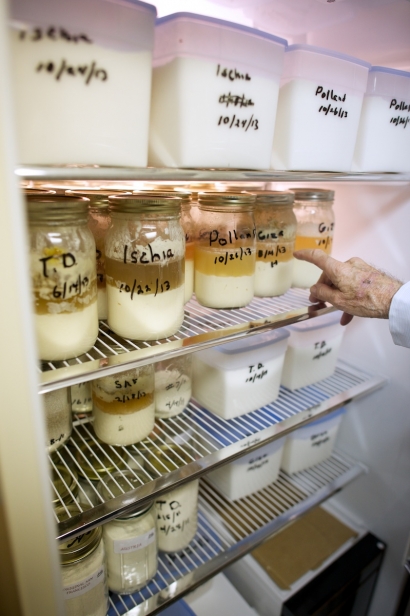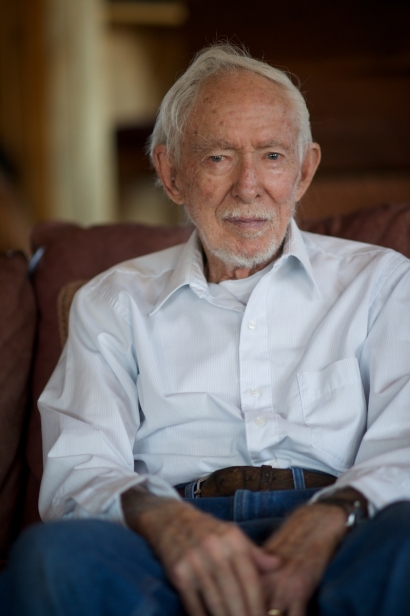Getting Cultured
In his area of expertise, he is one of the most renowned doctors in the world. Ed Wood (M.D., Ph.D.) is a physician, a research scientist and a pathologist who has spent a life-time putting his extensive education to use in a most unusual way. Wood is a doctor of dough; more precisely, sourdough.
“I don’t produce bread to sell,” he clarifies. “I collect cultures for people to make bread.”
At 88, Wood runs his international sourdough business out of the remote log home he built outside Cascade, Idaho, more than 25 years ago. On the main floor, we pass sweeping views of Round Valley before descending to the basement where Wood conducts his sourdough research. His laboratory is a tidy room filled with freezers, refrigerators and bubbling, yeasty jars of sourdough starters.
“This is what an active culture looks like, this bubble formation,” says Wood, holding out a jar for me to see. “That’s from the wild yeast.”
For Wood, the intrigue of natural leavens began when he was a young man and with his first sample of sourdough, it was love at first bite. “It has always amazed me that unknown, invisible things from our environment can taste so good,” he says. With his palate whetted, he began his quest for cultures in Saudi Arabia where he served as chairman of pathology at Riyadh hospital. He says the hospital had an excellent microbiology department which he used to study sourdough cultures that he and his late wife Jean collected from small bakeries in neighboring desert towns.
The couple shared their knowledge and their sourdough cultures, authoring several articles and books. Following Wood’s retirement and return to the States, they established Sourdoughs International (SDI).
Then, in 1991, an unprecedented door to the past opened for the Woods—a time tunnel of sorts. Archaeologists had unearthed an ancient bakery in Giza, Egypt, one believed to have fed tens of thousands of pyramid builders in 4500 B.C.
“To me that meant, wow, a [sourdough] culture from early Egypt! That really fascinated me,” Wood says. He quickly tracked down the archaeologist and made a proposition. “I asked if he’d be interested in me scraping the walls of the old bakery to find the first natural leaven. He said ‘that’s a great idea;’ he was totally enthused.”
He wasn’t the only one enthused. National Geographic also wanted in on the action. Two years later the magazine sent Wood and his wife to Giza for two weeks, documenting the story for later publication.
“After digging around, we eventually came up with the Giza culture,” Wood said. The retrieval process and the replication of the ancient baking practice were documented in the January 1995 edition of National Geographic. While National Geographic got the story, the Woods got what they came for.
The Giza culture is one of 17 varieties of exotic sourdough starters SDI produces, packages and sells to bakers in more than 75 countries. Other varieties hail from Italy, Austria, New Zealand, Saudi Arabia and, of course, San Francisco. “Articulating the differences [in flavor] with words is difficult,” Wood says. “They all taste like the country of origin, from camel hair to the Tasmanian devil.”
But more than the origin of the cultures, Wood believes it’s the slow, natural process by which the bread rises that truly impacts the flavor and quality of the bread. He says the wild yeast and bacteria (usually lactobacilli) that combine to make a natural leaven create far superior bread than those made from the more commonly used dry baker’s yeast, first introduced in the late 1800s. While commercial yeast expedites the process, Wood says it compromises the product.
“Since the introduction of commercial yeast during the industrial revolution,” he declares, “bread has been lousy.”
The dozens of baked breads on his counter are clearly not of that industrial ilk. They differ in height, density and shape—each an example of the kind of bread made in the countries where he collected each starter. But you can also see a quintessential commonality. “This is a characteristic sourdough formation,” he says, pointing to the holes in the sliced bread.
Of his numerous cultures, Wood says the Giza and the San Francisco varieties are the top sellers. But, even more important to Wood than the quantity of sales is his earnest hope that more home bakers will discover the virtue of natural leavens. “What we’re interested in doing is convincing the public that the new odyssey of bread is real and that natural leavens work.”







